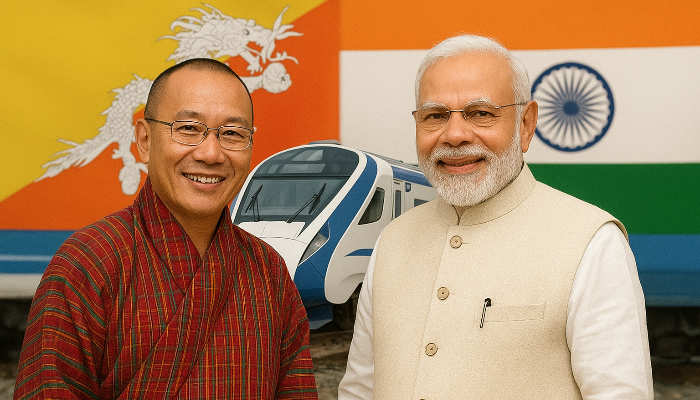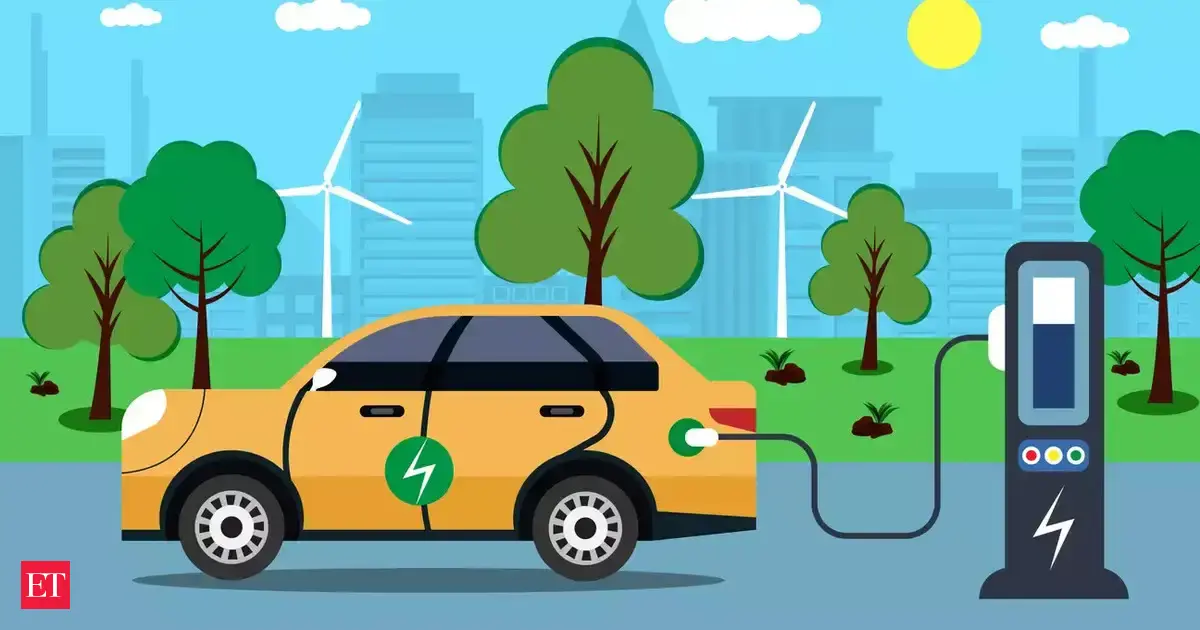India and Bhutan announce first-ever railway links: How this cross-border railway project goes beyond connectivity
By Rukma Rathore
Copyright opindia

A historic plan to build rail connectivity between India and Bhutan has been unveiled by the central government on 29th September. It will be the first cross-border railway project in Bhutan. It is a part of the ambitious “Make in India” initiative.
Union Minister Ashwini Vaishnaw and Foreign Secretary Vikram Misri revealed plans to build new railway linkages that will cost Rs 4,033 crore. It will connect the industrial city of Samtse and Gelephu, a centre for mindfulness. The Indian Railways network would be linked to both lines at Banarhat in West Bengal and Kokrajhar in Assam.
Foreign Secretary Vikram Misri declared that these two projects are a part of the first batch of rail connection projects between the nations. “There is a major new initiative between India and Bhutan on the establishment of rail connectivity between our two countries,” he added.
A new beginning between two significant partners
A formal agreement was signed during the Bhutanese Foreign Secretary’s visit to New Delhi and the Memorandum of Understanding for these projects was reached amid Prime Minister Narendra Modi’s visit to Bhutan in March of the last year. “The total length is about 90 kilometres to be precise and 89 kilometres of railway network will be created,” informed Vaishnaw.
He outlined, “India is the largest trading partner of Bhutan and most of the exempt trade of Bhutan is done through Indian ports. Therefore, it becomes very important to have a good seamless rail connectivity for the Bhutanese economy to grow and for the people to have better access to the global network. That’s why this entire project has been undertaken.”
Bhutan would have access to 1,50,000 kilometres of the Indian railway network owing to the rail linkages. The Banarhat-Samtse line would be built over a three-year period while the Kokrajhar-Gelephu rail link would be developed over the following four years. The railway lines would be built to accommodate electrified Vande Bharat trains.
Promised & delivered – India & Bhutan to establish two cross-border rail links (89 km | ₹4,033 Cr) 🇮🇳🇧🇹🛤️ Kokrajhar–Gelephu (69 km)🛤️ Banarhat–Samtse (20 km)✅ This milestone will unlock new economic opportunities, strengthen connectivity, and deepen India–Bhutan ties. pic.twitter.com/J5fX60NS9k— Ashwini Vaishnaw (@AshwiniVaishnaw) September 29, 2025
The Indian government will cover the cost of the railway lines and all train coaches as well as technology would be produced domestically. There will be six stations, two viaducts, 29 major bridges, 65 minor bridges, two sheds, one flyover and 39 underpasses along the roughly 69 kilometer Kokrajhar-Gelephu line with Rs 3456 crore.
Two stations, 25 bridges, one major flyover, 24 minor flyovers and 37 underpasses will all be built as part of the 20 kilometer Banarhat-Samtse line at the cost of Rs 577 crore.
Misri conveyed, “As you are all aware, India and Bhutan share a relationship of exceptional trust, mutual respect and understanding. This is a relationship that is rooted in cultural and civilizational ties, extensive people-to-people relations, and our shared developmental and security interests. These ties are reflected in very close contact at the highest levels.”
He reported, “These links that are being worked on will be critical for enhancing cargo and passenger movement. So, it is in the context of this very special relationship that the two governments have agreed to establish two cross-border rail links between Banarhat and Samtse and Kokrajhar and Gelephu. This will be the first set of rail connectivity projects with Bhutan.”
According to Misri, the railway ministry will finance the Indian portions of the two linkages while New Delhi will provide Rs 10,000 crore for Bhutan’s 13th five-year plan for 2024-2029 to build the sections inside Bhutanese territory. The sections that lie on the Bhutanese side of both lines are little longer than two kilometres.
The work on both projects, including the purchase of land will commence shortly. The two nations will work out security arrangements while the Land Ports Authority of India builds a number of new integrated check posts (ICPs) along the Bhutanese border.
“India and Bhutan share a relationship of exceptional trust, mutual respect and understanding. This is a relationship that is rooted in cultural and civilizational ties, extensive people-to-people relations and our shared developmental and security interests,” Misri further pointed out.
Jigme Khesar Namgyel Wangchuck, the King of Bhutan, established Gelephu as the location of an independent economic centre with administrative, legislative and judicial authority. The Indian government has expressed support for the flagship project which aims to establish broad commercial and other ties between Bhutan and the Indian subcontinent.
Bhutan will be able to access India’s vast railway network owing to the two new train links which will also make it easier for commodities to go to seaports and to third nations like Bangladesh and Nepal.
More to the development than meets the eye
Bhutan serves as an essential trading partner for India, however, its significant location further enhances its importance for New Delhi. It is a land locked between India and China in the Eastern Himalaya. Four Indian states, Assam, Arunachal Pradesh, West Bengal and Sikkim share a 699 kilometer open border with it.
Consequently, it is increasingly vital for New Delhi to cultivate strong relationships with its neighboring countries, despite the recent thaw in relations with Beijing. Trump’s second term has reminded New Delhi that world leaders cannot be taken at face value, and even trusted partnerships can falter. The Hence, the railway project is a substantial move in the same direction.
While differing perceptions on border and line of control has often been the root cause of conflicts between India and China, most notably illustrated by the Galwan Valley clashes in 2020, and before that in Doklam, a strategically important plateau and valley at the intersection of China, Bhutan and India, the new rail connectivity serves to strengthen the close strategic cooperation between India and Bhutan. Interestingly, Bhutan and India acknowledge Doklam as a Bhutanese territory while China disputes this.
The two armies engaged in the largest military standoff in recent memory. It began when the People’s Liberation Army (PLA) of China built a road on the Doklam plateau, which China claims is part of its Donglang province, and the Indian Army protested. An old Indian army bunker wwas demolished by the People’s Liberation Army there.
China even blocked the access across Sikkim’s Nathu La route towards Kailash-Mansarovar in response to the confrontation. Moreover, the two sides escalated the number of their troops in the region.
The fact that India occupied the heights and was therefore tactically in a far better position than China was evident from the start. New Delhi successfully managed to stare down Beijing after a 73-day conflict that lasted from 16th June to 28th August preceded by numerous rounds of negotiations between the two sides.
The Sikkim, Bhutan and Tibet trijunction is strategically and defensively important to India and the advantage would have been lost if the road had been constructed in the area. This illustrates the vitality of ties between India and Bhutan to counter China.
“Neighbourhood First Policy” of Modi government and development in Northeastern states
In addition to security implications, the rail links also enshrines Modi government’s “Neighbourhood First Policy.” Originally proposed in 2008, the “Neighbourhood First Policy” came in the spotlight after PM Modi was voted to power in 2014. It directs India’s approach to managing relations with nations in its near neighbourhood, such as Sri Lanka, Bangladesh, Afghanistan and Bhutan.
Its goal is to increase trade and business while also improving physical, digital and interpersonal connectivity throughout the region. However, it also seeks to establish interdependencies that bolster India’s authority and challenge outside influences.It strives to ensure a stable regional environment by fostering confidence and fortifying diplomatic ties.
India can cement itself as a regional power in South East Asia by working closely with its neighbours. The recent development concerning Bhutan represents a continuation of the same. Moreover, New Delhi’s leading position in advancing the Global South’s interests in international fora is strengthened by working alongside its neighbours. This promotes improved comprehension and collaboration on international matters.
China currently enjoys a significant presence in the Indian subcontinent and has made substantial investments in nations such as Nepal, Sri Lanka and Pakistan its “all-weather friend.” Therefore, it is increasingly vital for India to strengthen its relationships with its neighbours.
Furthermore, alongside nurturing positive relationships with neighbours, the policy also serves as a catalyst for growth and progress in the Northeastern region of the country. This area has historically been overlooked by successive Congress-led governments and has lacked even basic infrastructure.
The development story of the Northeast only commenced after the Modi government came to power. Security is closely related to both internal and regional connectivity and therefore, the infrastructure not only benefited the local population but also a new wave of development in the region long neglected by New Delhi under previous regimes.
The government has also been making a concerted effort to bring Northeast India closer to the rest of the nation since 2014. Prime Minister Narendra Modi’s “Vikas through connectivity” agenda is driving the government’s development of infrastructure, particularly railways, as the primary tool for promoting socioeconomic advancement and national integration.
Major railway projects like the Bairabi–Sairang line in Mizoram, the Dimapur-Zubza line in Nagaland, the Sevoke-Rangpo project in Sikkim, and the engineering marvel Bogibeel Bridge in Assam connecting to Arunachal Pradesh have brought tangible progress to the Seven Sisters and One Brother of India, supported by the central government’s persistent focus on “Act East” and infrastructure-led growth.
Substantial advancements have also been made along the Line of Actual Control, which encompass the development of roads, remote area infrastructure, dams and national highways to improve connectivity with the rest of the nation while bolstering security.
Similarly, the railway network connecting India and Bhutan will not merely boost connectivity between the peoples of these two countries and promote infrastructure growth, but may likely usher into greater strategic and geopolitical cooperation.
Stamp of India’s authority as a confident regional power
The announcement of the railway connection between India and Bhutan represents not only a significant achievement for the country’s foreign policy but also an astute geopolitical move that cements India’s standing as a confident regional power. Moreover, it paves the way for the development of India’s Northeast, which is a key component of the Modi administration’s development agenda.
Furthermore, New Delhi’s energy needs can be satisfied by Bhutan’s enormous hydroelectric resources.
Bhutan is primarily a Buddhist nation. India is the birthplace of Buddhism and hosts a lively Buddhist community in addition to its Hindu majority. This can only act as an additional binding force in the strong cultural ties between the two partners.



